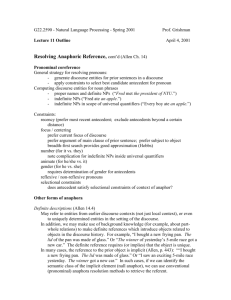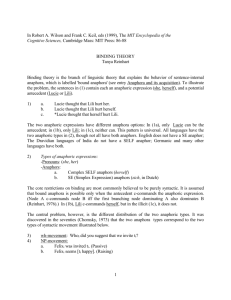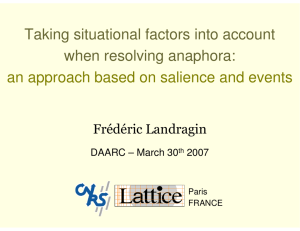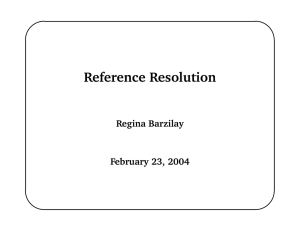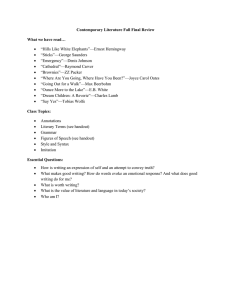Automated Acquisition of Anaphora Resolution Strategies
advertisement
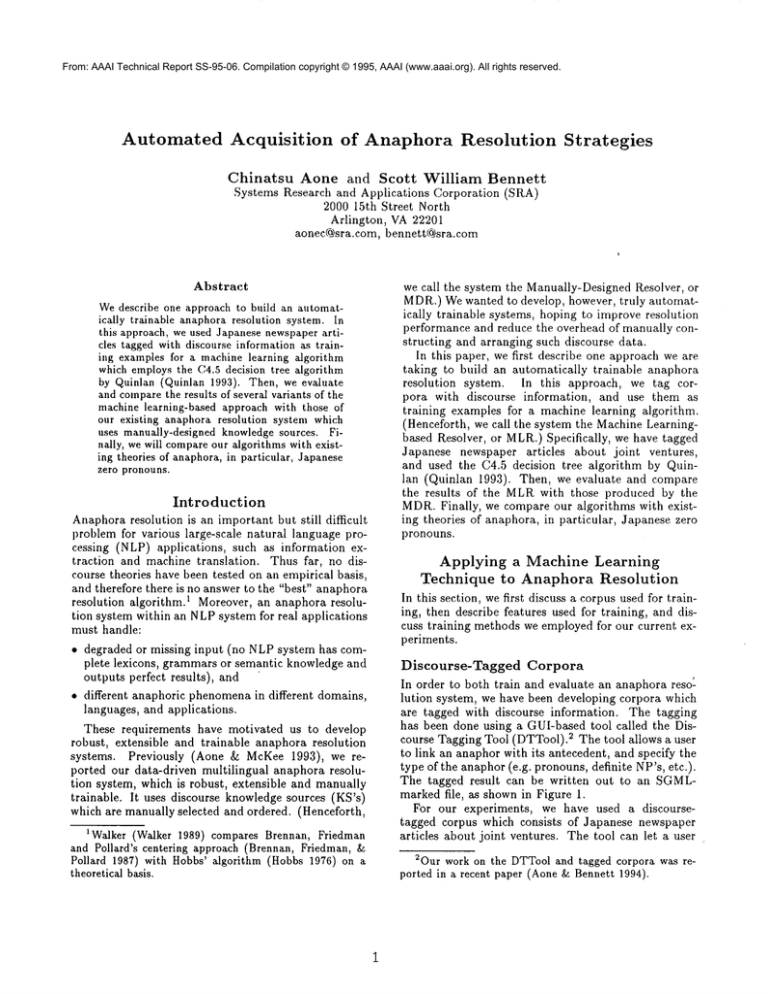
From: AAAI Technical Report SS-95-06. Compilation copyright © 1995, AAAI (www.aaai.org). All rights reserved. Automated Acquisition of Anaphora Resolution Strategies Chinatsu Aone and Scott William Bennett Systems Research and Applications Corporation (SRA) 2000 15th Street North Arlington, VA22201 aonec(@sra.com, bennettC@sra.com Abstract Wedescribe one approach to build an automatically trainable anaphora resolution system. In this approach, we used Japanese newspaperarticles tagged with discourse information as training examples for a machine learning algorithm which employsthe C4.5 decision tree algorithm by Quinlan (Quinlan 1993). Then, we evaluate and comparethe results of several variants of the machine learning-based approach with those of our existing anaphora resolution system which uses manually-designed knowledgesources. Finally, we will compareour algorithms with existing theories of anaphora, in particular, Japanese zero pronouns. Introduction Anaphoraresolution is an important but still difficult problem for various large-scale natural language processing (NLP) applications, such as information extraction and machine translation. Thus far, no discourse theories have been tested on an empirical basis, and therefore there is no answer to the "best" anaphora resolution algorithm. 1 Moreover, an anaphora resolution system within an NLPsystem for real applications must handle: ¯ degraded or missing input (no NLPsystem has complete lexicons, grammars or semantic knowledge and outputs perfect results), and ¯ different anaphoric phenomenain different domains, languages, and applications. These requirements have motivated us to develop robust, extensible and trainable anaphora resolution systems. Previously (Aone & McKee 1993), we reported our data-driven multilingual anaphora resolution system, which is robust, extensible and manually trainable. It uses discourse knowledgesources (KS’s) which are manually selected and ordered. (Henceforth, IWalker (Walker 1989) compares Brennan, Friedman and Pollard’s centering approach (Brennan, Friedman, Pollard 1987) with Hobbs’ algorithm (Hobbs 1976) on theoretical basis. we call the system the Manually-Designed Resolver, or MDR.)Wewanted to develop, however, truly automatically trainable systems, hoping to improve resolution performance and reduce the overhead of manually constructing and arranging such discourse data. In this paper, we first describe one approach we are taking to build an automatically trainable anaphora resolution system. In this approach, we tag corpora with discourse information, and use them as training examples for a machine learning algorithm. (Henceforth, we call the system the Machine Learningbased Resolver, or MLR.)Specifically, we have tagged Japanese newspaper articles about joint ventures, and used the C4.5 decision tree algorithm by Quinlan (Quinlan 1993). Then, we evaluate and compare the results of the MLRwith those produced by the MDR.Finally, we compare our algorithms with existing theories of anaphora, in particular, Japanese zero pronouns. Applying a Machine Learning Technique to Anaphora Resolution In this section, we first discuss a corpus used for training, then describe features used for training, and discuss training methods we employed for our current experiments. Discourse-Tagged Corpora In order to both train and evaluate an anaphora reso: lution system, we have been developing corpora which are tagged with discourse information. The tagging has been done using a GUI-based tool called the Discourse Tagging Tool (DTTool).2 The tool allows a user to link an anaphor with its antecedent, and specify the type of the anaphor (e.g. pronouns, definite NP’s, etc.). The tagged result can be written out to an SGMLmarkedfile, as shownin Figure 1. For our experiments, we have used a discoursetagged corpus which consists of Japanese newspaper articles about joint ventures. The tool can let a user 2Our work on the DTTooland tagged corpora was reported in a recent paper (Aone &Bennett 1994). Figure 1: Text Tagged with Discourse Information using SGML define types of anaphora as necessary. The anaphoric types used to tag this corpus are shown in Table 1. The DNPanaphora are characteristic of written, but not spoken, Japanese texts. NAMEanaphora are tagged when proper names are used anaphorically. For example, to illustrate in English, "Toyota" and "Mr. Clinton" referring back to "Toyota Motor Corp." and "Bill Clinton" respectively are NAMEanaphora. NAMEanaphora in Japanese are different from those in English in that any combination of characters in an antecedent can be NAME anaphora as long as the character order is preserved (e.g. "abe" can be an anaphor of "abcde’). Japanese definite NPs (i.e. DNPanaphora) are those prefixed by "dou" (literally meaning "the same"), "ryou" (literally meaning "the two"), and deictic determiners like "kono"(this) and "sono" (that). For ample, "dou-sha" is equivalent to "the company", and "ryou-koku" to "the two countries". Unlike English, Japanese has so-called zero pronouns, which are not explicit in the text. In these cases, the DTTool lets the user insert a "Z" marker just before the main predicate of the zero pronoun to indicate the existence of the anaphor. Wemade distinction between QZPROand ZPROwhen tagging zero pronouns. QZPRO("quasi-zero pronoun") is chosen when a sentence has multiple clauses (subordinate or coordinate), and the zero pronouns in these clauses refer back to the subject of the initial clause in the same sentence, as shown in Figure 2. The anaphoric types are sub-divided according to more semantic criteria such as organizations, people, location, etc. This is because the current application of our multilingual NLPsystem is information extraction (Aone et aL 1993), i.e. extracting from texts information about which organizations are forming joint ventures with whom.Thus, resolving certain anaphora (e.g. various ways to refer back to organizations) affects the task performance more than others, as we previously reported (Aone 1994). Wewant to customize and evaluate anaphora resolution systems according to the types of anaphora when necessary. Training Features In our current machine learning experiments, we have taken an approach where we train a decision tree by feeding feature vectors for pairs of an anaphor and its possible antecedent. Currently we use 66 features, and they include lezical (e.g. category), syntactic (e.g. grammaticalrole), semantic (e.g. semantic class), and positional (e.g. distance between anaphor and antecedent) features. Those features can be either unary features (i.e. features of either an anaphor or an antecedent such as syntactic number values) or binary features (i.e. features concerning relations between the pairs such as positional relation between an anaphor and an antecedent.) Westarted with the features used by the MDR,generalized them, and added new features. Example of training features are shown in Table 2. The feature values are obtained automatically by processing a set of texts with our NLPsystem, which performs lexical, syntactic and semantic analysis and then creates discourse markers (Kamp1981) for each NP and S. 3 Since discourse markers store the output of lexical, syntactic and semantic processing, the feature vectors are automatically calculated from them. Because the system output is not always perfect (especially given the complex newspaper articles), however, there is somenoise in feature values. Training Method Wehave employed different training methods using three parameters: anaphoric chains, anaphoric type identification, and confidence factors. The anaphoric chain parameter is used in selecting training examples. Whenthis parameter is on, we selected a set of positive training examples and a set of negalive training examples for each anaphor in a text in the following way: Positive training examples are those anaphorantecedent pairs whose anaphor is directly linked to its antecedent in the tagged corpus and also whose anaphor is paired with one of the antecedents on the 3Existence of zero pronounsin sentences is detected by the syntax module, and discourse markers are created for them. Tags DNP DNP-F DNP-L DNP-ORG DNP-P DNP-T DNP-BOTH DNP-BOTH-ORG DNP-BOTH-L DNP-BOTH-P REFLEXIVE NAME NAME-F NAME-L NAME-ORG NAME-P DPRO LOCI TIMEI QZPRO QZPRO-ORG QZPRO-P ZPRO ZPRO-IMP ZPRO-ORG ZPRO-P JDEL Meaning Definite NP Definite NP whose referent is a facility Definite NP whose referent is a location Definite NP whose referent is an organization Definite NP whose referent is a person Definite NP whose referent is time Definite NP whose referent is two entities Definite NP whose referent is two organization entities Definite NP whosereferent is two location entities Definite NP whose referent is two person entities Reflexive expressions (e.g. "jish£’) Proper name Proper name for facility Proper name for location Proper name for organization Proper name for person Deictic pronoun (this, these) Locational indexical (here, there) Time indexical (now, then, later) Quasi-zero pronoun Quasi-zero pronoun whose referent is an organization Quasi-zero pronoun whose referent is a person Zero pronoun Zero pronoun in an impersonal construction Zero pronoun whose referent is an organization Zero pronoun whose referent is a person Dou-ellipsis Table 1: Summary of Anaphoric Types SONY-wa Sony-subj RCA-to RCA-with teikeishi, joint venture VCR-wo VCR-obj kaihatsusuru develop to that QZPRO (it) happyoushita announced "(SONY) announced that SONYwill and (it) will develop VCR’s." Figure Lexical Syntactic Semantic Positional form a joint QZPRO (it) venture with RCA 2: QZPRO Example Unary feature category-propn topicalized semantic-class Binary feature matching-category matching-topicalized subsuming-semantic-class anaphor- antecedent-dist ance Table 2: Examples of Training 3 Features anaphoricchain, i.e. tim transitive closure betweentile anaphor and the first mentioning of the antecedent. For example, if B refers to A and C refers to B, C-Ais a positive training example as well as B-Aand C-B. Testing and Evaluation Scoring Method Weused recall and precision metrics, as shown in Table 3, to evaluate the performance of anaphora resolution. It is important to use both measures because one can build a high recall-low precision system or a low recall-high precision system, neither of which may be appropriate in certain situations. The NLPsystem sometimesfails to create discourse markers exactly corresponding to anaphora in texts due to lexical or syntactic processing. In order to evaluate the performance of the anaphora resolution systems themselves, we only considered anaphora whose discourse markers were identified by the NLPsystem in our evaluation. Thus, the system performance evaluated against all the anaphora in texts could be different. Negative training examples are chosen by pairing an anaphor with all the possible antecedents in a text except for those on the transitive closure described above. Thus, if there are possible antecedents in the text which are not in the C-B-Atransitive closure, say D, C-D and B-D are negative training examples. The anaphoric type identification parameter is utilized in training decision trees. With this parameter on, a decision tree is trained to answer "no" when a pair of an anaphor and a possible antecedent are not co-referential, or answer the anaphoric type whenthey are co-referential. If the parameter is off, a binary decision tree is trained to answer just "yes" or "no", and does not have to answer the types of anaphora. I N~ Nh The confidence factor parameter (0-100) is used pruning decision trees. With a higher confidence factor, less pruning of the tree is performed, and thus it tends to overfit the training examples. With a lower confidence factor, more pruning is performed, resulting in a smaller, more generalized tree. Weused confidence factors of 25, 50, 75 and 100%. Recall = N¢/I, Precision = N~/Nh Numberof system-identified anaphora in input Numberof correct resolutions Numberof resolutions attempted Table 3: Recall and Precision Metrics for Evaluation Testing the MLR and the MDR To build MLRs,we trained decision trees with 1971 anaphora 4 (of which 929 were NAME-ORG; 546 QZPRO-ORG; 87 DNP-ORG; 282 ZPRO-ORG) in 295 training texts. The six MLR’susing decision trees with different parameters are described in Table 4. The same training texts used by the MLR’sserved as development data for the MDR.Because the NLP system is used for extracting information about joint ventures, the MDRwas configured to handle only the crucial subset of anaphoric types for this experiment, namely NAME-ORG, DNP-ORG, QZPRO-ORG, and ZPRO-ORG. The MDRapplies different sets of generators, fillers and orderers to resolve different anaphoric types. A generator generates a set of possible antecedent hypotheses for each anaphor, while a filter eliminates unlikely hypotheses from the set. An orderer ranks hypotheses in a preference order if there is more than one hypothesis left in the set after applying all the applicable filters. Table 5 shows KS’s employed for the four anaphoric types. The testing was done using 1359 anaphora (of which 1271 were one of the four anaphoric types) in 200 blind test texts for both the MLRsand the MDR.It should be noted that both the training and testing texts are newspaper articles about joint ventures, and that each article always talks about more than one organization. Thus, finding antecedents of organizational anaphora is not straightforward. Table 6 shows the results of The anaphoric chain parameter described above was employed because an anaphor may have more than one "correct" antecedent, in which case there is no absolute answer as to whether one antecedent is better than the others. The decision tree approach we have taken may thus predict more than one antecedent to pair with a given anaphor. Currently, confidence values returned from the decision tree are employed when it is desired that a single antecedent be selected for a given anaphor. We are experimenting with techniques to break ties in confidence values from the tree. One approach is to use a particular bias, say, in preferring the antecedent closest to the anaphor among those with the highest confidence (as in the results reported here). Another approach is to use a hybrid approach where a preference-trained decision tree is brought in to supplement the decision process. Preference-trained trees, like that discussed in Connollyet al. (Connolly, Burger, & Day 1994), are trained by presenting the learning algorithm with examples of when one anaphorantecedent pair should be preferred over another. Despite the fact that such trees are learning preferences, they maynot produce sufficient preferences to permit selection of a single best anaphor-anteeedent combination (see the "Related Work" section below). This shortcoming is not likely to be as critical when such a tree is used along with other methods to help select a final pair from a set of possible antecedents all with high confidence. 4in both training and testing, we did not include anaphora which refer to multiple discontinuous antecedents. 4 anaphoric chain MLR-1 MLR-2 MLR-3 MLR-4 MLR-5 MLR-6 anaphoric type identification yes yes yes yes yes yes yes yes yes no no yes Table 4: Six Configurations confidence factor 100% 75% 50% 25% 75% 75% of MLR’s NAME-ORG Generators current-text Filters syntactic-category-propn narne-char-subsequence semantic-class-org semantic-class-org semantic-amount-singular DNP-ORC current-text QZPRO-ORG current-paragraph not-in-the-same-dc semantic-class-from-pred ZPRO-ORG current-paragraph not-in-the-same-dc sem antic-class-from-pred Orderers reverse-recency topicalization subject-np recency topicalization subject-np category-np recency topicalization subject-np category-np recency Table 5: KS’s used by the MDR six different anaphora. MLRsand the MDRfor the four types of type identification parameter both helped improve the MLRs. Our experiments with the confidence factor parameter indicates the trade off between recall and precision. With 100% confidence factor, which means no pruning of the tree, the tree overfits the examples, and leads to spurious uses of features such as the number of sentences between an anaphor and an antecedent near the leaves of the generated tree. This causes the system to attempt more anaphor resolutions albeit with lower precision. With a confidence factor of 25%, the tree is over-generalized, and the system attempts to resolve fewer anaphora, resulting in lower recall but higher precision. This tunability of performance is, however, a very useful feature for practical applications. The MLRresults also seem to indicate the limitation of the MDRin the way it uses orderer KS’s. Currently, the MDRuses an ordered list of multiple orderer KS’s for each anaphoric type (cf. Table 5), where the first applicable orderer KS in the list is used to pick the best antecedent when there is more than one possibility. Such selection ignores the fact that even anaphora of the same type may use different orderers (i.e. have different preferences), depending on the context and history of how the particular anaphor was used in the text. Evaluation and Comparison Using F-measures 5 as an indicator for overall performance, the MLRs with the chain and type identification parameters turned on performed better than the MDR. However, the MDR had much higher recall in ZPRO-ORG.The MLRsalso learned to resolve other anaphoric types such as DPRO, REFLEXIVE, and TIMEI (of. Table 1) without additional work. Both the MLRs and the MDRused the character subsequence, the proper noun category, and the semantic class feature values for NAME-ORG anaphora. It is interesting to see the MLRsadditionally use the topicalization feature before testing the semantic class feature. This indicates that, information theoretically, if the topicalization feature is present, the semantic class feature is not needed for the classification. Changing the three parameters caused changes in anaphora resolution performance. As Table 6 shows, using the anaphoric chain parameter and the anaphoric 5 F-measure is calculated by: F= (f12+l.0) x Px fl2 xP+ R Related where P is precision, R is recall, and fl is the relative importance given to recall over precision. In this case, fl = 1.0. Work Anaphora resolution systems for English on various machine learning algorithms, 5 texts based including a exmpls MLR-I MLR-2 MLR-3 MLR-4 MLR-5 MLR-6 MDR NAME-ORG 631 R P 85.26 92.12 85.74 92.80 84.79 94.02 84.79 93.53 68.30 91.70 68.30 91.51 76.39 90.09 DNP-ORG 54 R P 44.44 60.00 44.44 55.81 42.59 60.53 37.04 60.61 29.63 64.00 37.04 74.07 35.19 50.00 QZPRO-ORG 383 R P 58.22 84.47 56.66 90.04 56.40 90.00 51.44 93.36 54.31 91.23 50.39 93.24 67.10 67.10 ZPRO-ORG 203 R P 18.72 66.67 15.76 82.05 13.30 81.82 0.49 33.33 13.30 77.14 0.49 33.33 43.35 43.35 Average 1271 R P 64.75 87.09 64.04 89.85 63.02 91.02 59.24 91.94 53.66 89.97 50.75 91.10 66.56 72.18 F-measure 1271 F 74.28 74.78 74.48 72.05 67.23 65.19 69.26 Table 6: Recall and Precision decision tree algorithm, are reported in Connolly et al. (Connolly, Burger, & Day 1994). Our approach different from theirs in that their decision tree identifies which of the two possible antecedents for a given anaphor is "better". The assumption seems to be that the closest antecedent is the "correct" antecedent. However, they note a problem that their decision tree is not guaranteed to return consistent classifications given that the "preference" relationship between two possible antecedents is not transitive. Zero pronoun resolution for machine translation reported by Nakaiwa and Ikehara (Nakaiwa & lkehara 1992) used only semantic attributes of verbs in a restricted domain. The small test results (102 sentences from 29 articles) had high success rate of 93%. However, the input was only the first paragraphs of newspaper articles which contained relatively short sentences. Our anaphora resolution systems reported here have the advantages of domain-independence and full-text handling without the need for creating an extensive domain knowledge base. Various theories of Japanese zero pronouns have been proposed by computational linguists, for example, Kameyama (Kameyama 1988) and Walker et al. (Walker, lida, & Cote 1994). Although these theories are based on dialogue examples rather than texts, "features" used by these theories and those by the decision trees overlap interestingly. For example, Walker el al. proposes following ranking scheme to select antecedents of zero pronouns. which the systems make, and continue to improve system performance. Specifically, due to the way in which zero pronouns were tagged in the text, the MLR’s were not trained on zero pronoun-zero pronoun pairs. We believe that, had it been trained on these, the ZPROORG performance would have been much improved. References Aone, C., and Bennett, S.W. 1994. Discourse TaggingTool and Discourse-tagged Multilingual Corpora. In Proceedings of International Workshop on Sharable Natural Language Resources (SNLR). Aone, C., and McKee, D. 1993. LanguageIndependent Anaphora l~esolution System for Understanding Multilingual Texts. In Proceedings of 31st Annual Meeting of the ACL. Aone, C.; Flank, S.; Krause, P.; and McKee, D. 1993. SRA: Description of the SOLOMONSystem as Used for MUC-5. In Proceedings of Fourth Message Understanding Conference (MUC-5). Aone, C. 1994. Customizing and Evahlating a Multilingual Discourse Module. In Proceedings of the 15th International Conference on Computational Linguistics. Brennan, S.; Friedman, M.; and Pollard, C. 1987. A Centering Approach to Pronouns. In Proceedings of 25th Annual Meeting of the A CL. Connolly, D.; Burger, J. D.; and Day, D. S. 1994. A Machine Learning Approach to Anaphoric l~eference. In Proceedings of International Conference on New Methods in Language Processing (NEMLAP). (GRAMMATICAL or ZERO) TOPIC > EMPATHY SUBJECT > OBJECT2 > OBJECT > OTHERS Our decision tree uses the following features for QZPRO-ORGin this order: topicalization, distance between an anaphor and an antecedent, semantic class of an anaphor and an antecedent, and subject NP. We plan to analyze further the features which the decision tree has used for zero pronouns, and compare them with these theories. Hobbs, J. R. 1976. Pronoun Resolution. Technical Report 76-1, Department of Computer Science, City College, City University of New York. Kameyama, M. 1988. Japanese Zero Pronominal Binding, where Syntax and Discourse Meet. In Papers from the Second International Worksho on Japanese Syntax. Summary and Future Work Kamp, H. 1981. A Theory of Truth and Semantic Representation. In Groenendijk, J., et al., eds., Forreal Methods in the Study of Language. Amsterdam: Mathematical Centre. The work reported in this paper is an encouraging step toward automating acquisition of anaphor resolution strategies. Wewill further analyze the types of errors 6 Nakaiwa, H., and lkehara, S. 1992. Zero Pronoun Resolution in a Japanese to English Machine Translation Systemby using Verbal Semantic Attribute. In Proceedings of the Fourth Conference on Applied Natural LanguageProcessing. Quinlaa, J. R. 1993. C/t.5: Programs for Machine Learning. Morgan Kaufmann Publishers. Walker, M.; lida, M.; and Cote, S. 1994. Japanese Discourse and the Process of Centering. Computational Linguistics 20(2). Walker, M. A. 1989. Evaluating Discourse Processing Algorithms. In Proceedings of 27th Annual Meeting of the ACL. 7

